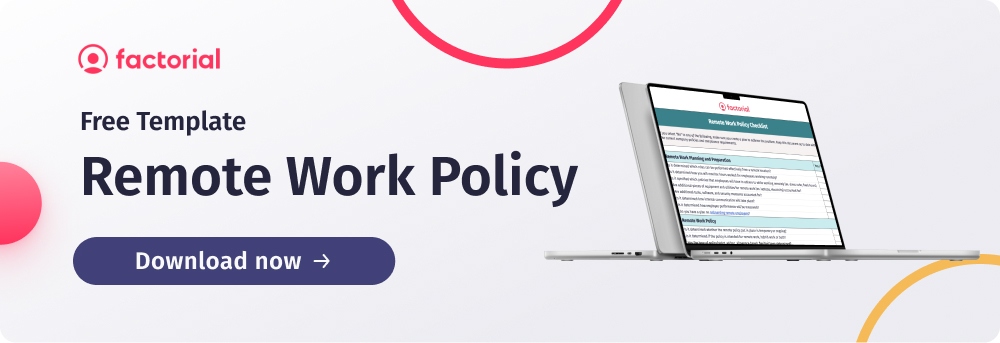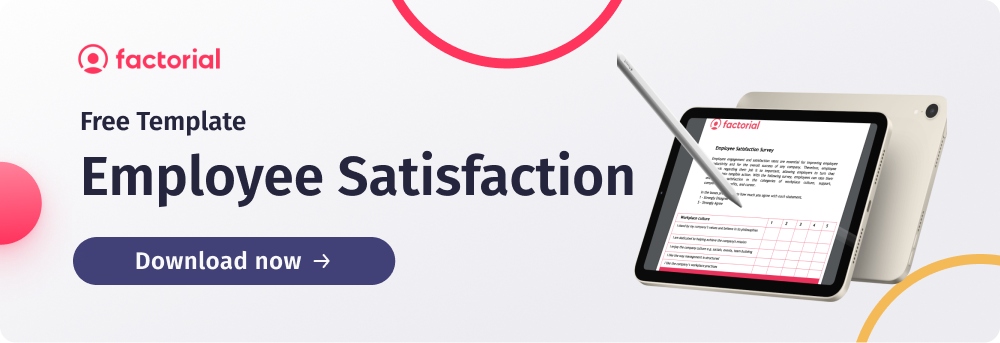Employee benefits are what differentials employers from one another. If you’re looking to attract or retain top talent, it could be a matter of improving your employee benefits to keep your team happy. Typically, the best benefit schemes motivate your team to be productive and highly engaged.
Although as an employer, choosing employee benefit plans can be confusing and overwhelming to choose. Whether you’re looking for ideas or need help creating an employee benefit scheme for you team, we’ve got you covered. In this article, we will define employee benefits, their advantages, give you a list of the top 10 benefits and walk you through step-by-step on how to design an effective scheme.
✅Try Factorial Free for 7 Days
What are Employee Benefits?
Employee benefits are perks that go beyond the regular salary pack. These can make or break an employee’s decision to leave or stay at a company. They can come in many different forms, from health insurance and retirement plans to paid time off and flexible work arrangements. These perks are designed to improve the quality of life of employees and help them achieve a better work-life balance. An example of an employee benefit is student loan repayments. Although it is up to the employer to determine which benefits their employees value most and which ones they’ll provide.
What is Employee Benefits Administration?
Employee Benefits Administration refers to the process of designing, implementing, and managing the various benefits and perks that a company offers to its employees. These benefits can go beyond the regular salary and may include:
- Health insurance
- Retirement plans
- Paid time off
- Flexible working hours
- Stock options
- Wellness programmes and other rewards.
In the UK, like in many other countries, providing attractive employee benefits has become a crucial aspect of talent acquisition and retention. It plays a significant role in creating a positive and engaging work environment, fostering employee satisfaction, and enhancing overall productivity. And finding good company benefits is why up to 40% of employees leave their current job, according to survey data by Forbes.
What is an Employee Benefits Trust (EBT)?
An Employee Benefit Trust (EBT) is a trust set up by an organisation to provide workers with benefits. The trust is funded by the organisation and is designed to hold and manage assets used to provide benefits. These benefits include pensions, life insurance, health insurance, bonuses and share ownership schemes.
When an organisation sets up an EBT, it transfers assets such as cash, shares or property into the trust. The trustees of the EBT are then responsible for managing these assets and using them to provide benefits. The organisation can contribute to the trust regularly, and the trustees can use the assets to pay for benefits as and when required.
One of the key benefits of an Employment Benefit Trust is that the assets held in the trust are separate from the organisation’s assets. This means that the assets held in the trust are protected if the organisation goes into administration or liquidation. It also means that benefits are protected, as they are held separately from the organisation’s assets.
Advantages of Implementing Employee Benefits Schemes
Despite the name, employee benefits don’t just benefit the employees. There are a series of gains for the organisation as a whole, not just the individual. Let’s take a look at just some of the reasons why employers offer a range of employee benefits:
-
Enhanced Employee Recruitment and Retention
An employee benefit scheme is pivotal in attracting top talent to organisations. In a competitive job market, job seekers often evaluate potential employers based on the entirety of the compensation package, including benefits. Companies that offer enticing benefits have a distinct advantage when recruiting skilled professionals. On top of that, these benefits contribute to organisations retaining employees, as employees are more likely to stay with an organisation that invests in their wellbeing and professional growth.
-
Improved Employee Engagement and Morale
Providing the best employee benefit packages contribute significantly to building a positive and engaging work environment. When employees feel that their wellbeing is a priority for the organisation, it can motivate employees. The availability of benefits like wellness programmes, flexible work arrangements and professional development opportunities demonstrates a commitment to employees’ holistic growth, boosting morale and overall job satisfaction.
-
Enhanced Employee Performance and Productivity
Employees with access to benefits that address their physical and mental wellbeing are more likely to be more focused and less stressed. As a result, offering types of work benefits that positively enhance their wellbeing increases their performance and productivity. In fact, happy employees are 13% more productive. An employee benefit scheme can help increase your employee happiness rates which in turn boosts your team’s and company’s overall performance.
Top 10 Employee Benefits
1. Flexible hours
Achieving work-life balance can be a struggle, which explains why the concept of flexible hours has grown in popularity so drastically. This approach to work schedules allows employees to choose when they work, as long as they work the required number of hours each week. This can be implemented in a few ways, such as:
- Flextime: Employees can choose their starting and finishing times under this arrangement, as long as they work the appropriate number of hours per week.
- Workweek compression: Allows employees to work their full-time hours in fewer days, for example, four ten-hour days instead of five eight-hour days.
- Part-time employment: Permits employees to work fewer hours than a full-time employee.
- Job sharing: Two or more employees share the obligations of a single full-time employee.
2. Working from home
Work from-home (WFH) or hybrid policies are becoming the norm. The idea is to allow employees to work from the convenience of their own homes, either full-time or part-time. WFH can both increase employees’ productivity and help with flexibility, allowing employees to work from anywhere.
WFH can also reduce significant costs for both the employee and the employer. Employees can save money on transportation, meals and clothing, while employers can save on office space and supplies.
3. Sabbatical leave
Employee burnout is a common consequence of today’s fast-paced work environments. As a result, sabbatical leaves have grown in popularity in recent years, allowing employees to take a longer vacation from work to rest, recharge and reconnect with their personal and professional aspirations. Sabbatical leave can positively impact:
- Creativity and productivity.
- Personal and professional development. They are an opportunity for employees to pursue goals, such as learning new skills.
- Work-life balance. Employees have more time to spend with family, pursue hobbies or take care of personal obligations.
Companies offering sabbatical leaves should create a standardised policy to ensure fairness and compliance. Some companies may offer full or partial pay, while others may not offer any pay during this time.
Since salary during a sabbatical can be an issue, be sure to discuss all monetary details and set clear goals for employees’ sabbatical, such as learning a new skill, volunteering or travelling.
Research has shown that 62% of UK workers would take sabbatical leave if they were offered it, so the demand is definitely there!
4. Bonuses
For decades, bonuses have been a cornerstone of employee pay packages. These can help to attract and keep employees who value financial incentives at work. There are many different types, including:
- Performance-based bonuses.
- Sign-on bonuses.
- Referral bonuses.
- Profit-sharing bonuses.
- Holiday bonuses.
- Annual bonuses.
5. Upskilling courses
These are training programmes that assist employees to learn new skills, gain new knowledge and stay up-to-date with industry trends. Here’s why upskilling courses make a great employee benefit:
- Increase employee motivation. Workers who believe they are learning and growing are more likely to be engaged and motivated at work.
- Improve work performance. Relevant training can help employees execute their jobs more effectively and efficiently. This can lead to increased productivity, greater quality work and better company results.
- Career growth: Being rewarded to learn more can fuel ambition.
6. 4 day work week
This once-unthinkable schedule is becoming more and more likely in the UK. The results from the largest ever pilot scheme revealed that shortening the work week leads to improved mental wellbeing, higher productivity and even increased business profit.
Implementing this could:
- Support employee work-life balance.
- Boost employee retention. By offering a four-day workweek, employers can attract and retain top talent who are seeking a better work-life balance, leading to a more satisfied and engaged workforce.
- Reduce absenteeism: A four-day workweek can lead to reduced absenteeism among employees, which can improve overall productivity and reduce the cost of employee absences.
7. Life Insurance
Life insurance is an important financial tool that can assist and safeguard employees’ loved ones in the case of sudden death. As a result, many firms provide life insurance as a benefit. It can provide:
- Peace of mind in knowing loved ones will be taken care of in the event of an unexpected death.
- Financial security. The lump sum payment provided by life insurance can help cover expenses such as funeral costs, outstanding debts and future living expenses.
- Low-cost coverage. Group life insurance offered through employers is often more affordable than individual policies and may require no medical exam.
8. Free Meals
The way to an employee’s heart is often through their stomach. Offering free or subsidised breakfast or lunch could:
- Boost employee morale. Free meals can create a positive work environment and give employees more of a reason to come into the office!
- Enhance company culture. Sharing meals gives people the opportunity to come together and socialise, strengthening team bonds.
Food keeps your team’s energies up and is easy to implement into your employee benefits scheme to enhance your workplace environment.
9. Wellbeing support
Employee wellbeing has become an increasingly important topic in the workplace in recent years, and businesses are recognising the need to support their employees in maintaining their physical, mental and financial wellbeing. Here are a few ways this can be achieved:
- Offering mental health support. This can include access to therapists or counsellors. Some companies may also offer meditation or mindfulness classes to help employees manage stress and anxiety.
- Implementing an Employee Assistance Programme (EAP). EAPs provide employees with access to resources and support for a variety of issues, including mental health, financial challenges and relationship problems.
-
Outsourcing financial coaches. Supporting employees with their finances can help to relieve the stress that comes with money management.
10. Retirement programmes
For some, retirement can be a daunting concept. Retirement programmes can help employees make the most of this time. Within your programme, you could include:
- Defined benefit plans. This pays a specific payment to an employee upon retirement based on characteristics such as salary and years of service.
- Employee Stock Ownership Plans (ESOPs). An ESOP allows employees to own a portion of the company for which they work, allowing them to earn a retirement income based on the firm’s performance.
How to Design an Effective Employee Benefits Scheme
A well-crafted employee benefit scheme requires careful consideration and planning to ensure that it meets the diverse needs and preferences of the workforce. Here are some steps to follow to ensure your employee benefits scheme is aligned with your organisation:
1. Conducting a Needs Assessment
Before choosing the benefit, organisations should understand what their employees actually want and need. Employers can do this by conducting a comprehensive needs assessment, which can be accomplished through various methods such as surveys and focus groups. When organisations actively involve employees in the process of deciding which benefit would be the best fit, they build an understanding of which benefits would be worth the financial investment. Analysing employee demographics is equally crucial, as different age groups and life stages often have distinct priorities when it comes to benefits.
2. Tailoring Benefits to Different Employee Segments
Every organisation comprises a diverse workforce with varying preferences and requirements. Recognising these differences and tailoring benefits to cater to different employee segments is essential for maximising the scheme’s impact. For instance, younger employees might place greater importance on professional development opportunities, while those with families might value childcare support or flexible work arrangements. Organisations can ensure that their benefits scheme is truly inclusive by offering a range of benefits that address these varying needs.
3. Prioritising Benefits Based On Employee Preferences
Whilst offering every conceivable benefit is impossible, organisations can make informed decisions by prioritising benefits based on employee preferences. This involves considering both the results of the needs assessment and industry best practices. Benefits that align with the preferences of most employees whilst also fulfilling key business objectives should take precedence in the design process. Prioritisation helps organisations allocate resources effectively and create a benefits package that resonates with employees.
4. Flexible Benefits versus Standard Packages
One of the crucial decisions in designing a benefits package is choosing between offering a standard package of benefits or providing employees with the flexibility to select benefits that suit their individual needs. Standard packages offer consistency and simplicity, whilst flexible benefits allow employees to customise their package according to their circumstances.
Measuring the Impact of Employee Benefits
Implementing employee benefits schemes is not just about offering perks; it’s also about understanding their impact on both employees and the organisation as a whole. Measuring this impact is essential for fine-tuning benefits offerings, making informed decisions, and ensuring that the investment in these schemes delivers tangible returns.
Here are some ways in which organisations can measure the success of any employee benefits schemes they introduce:
-
Employee Satisfaction and Engagement
Regularly gauging employee satisfaction and engagement levels can provide valuable insights into how well the benefits scheme meets employee needs. Surveys, feedback sessions, and anonymous suggestions enable organisations to identify areas of improvement and make necessary adjustments to benefits offerings.
-
HR Metrics
Monitoring HR metrics, such as employee retention, turnover rates, and absence levels, can help organisations assess the effectiveness of their benefits.
A decline in turnover rates following the implementation of new benefits could indicate that employees are more likely to stay with the company due to the enhanced benefits they receive. Organisations should also drill down into this data through effective exit interviews to understand the reasons for leaving.
For health-related benefits, monitoring metrics such as absenteeism rates and participation in wellness programmes can provide a clearer picture of the impact of health and wellness initiatives on employees’ physical and mental well-being. Managers can also capture qualitative data in one-to-ones with their team members to understand the impact of wellbeing-related benefits on individuals.
-
Cost-Benefit Analysis
Conducting a cost-benefit analysis allows organisations to assess whether the positive outcomes justify the financial investment in benefits. Comparing the costs of providing benefits with the value gained in terms of employee satisfaction, retention, and overall performance helps organisations evaluate the efficiency of their benefits schemes.
FAQs
What is the difference between an Employee Benefit Trust and Employee Ownership Trust?
An Employee Ownership Trust (EOT) is a type of ownership structure allowing people to own company shares. EOTs were introduced for UK workers in 2014 to encourage greater organisation ownership. Under this model, the shares in the organisation are held by a trust on your behalf.
EBTs are typically funded by the organisation, while EOTs are funded through the sale of shares to the trust. In any case, employers should seek professional advice when setting up an EBT or EOT and carefully consider the advantages and disadvantages of each option before making a decision.
What are the rules around EBTs in the UK?
In the UK, there are specific rules and regulations governing EBTs. One of the main reasons companies in the UK set up EBTs is to provide tax-efficient bonuses, share schemes and other benefits to team members. However, the tax benefits of EBTs are subject to certain conditions, and it is important to ensure that the EBT is set up and managed in compliance with these conditions.
There are also specific rules that apply to the management of EBTs in the UK. For example, EBTs are subject to the Trustee Act 2000, which sets out the duties and responsibilities of trustees. Trustees of EBTs must act in the best interests of the beneficiaries of the trust and must exercise reasonable care and skill when managing the trust. In addition, there are certain tax implications that companies should be aware of when setting up and managing EBTs in the UK.
Nonetheless, it’s well worth going through the arduous task of implementing such a structure. Research by the Employee Ownership Association shows how people who work in employee-owned companies are happier, healthier, and feel safer than people who don’t have a stake in their company.
How do you set up an EBT?
Setting up an EBT is complex, but the results can significantly benefit your organisation and team members. Here are some of the key steps to keep in mind when considering an EBT:
- Determine the purpose of the EBT.
- Choose a trustee with the necessary expertise and experience.
- Develop a trust deed that outlines the terms and conditions of the EBT.
- Fund the EBT with cash contributions, the transfer of shares or assets or a combination of both.
- Manage the EBT per the trust deed and applicable laws and regulations.
- Communicate with your team about the EBT and its benefits.
By following these steps, you can establish an EBT that meets everyone’s needs while complying with applicable laws and regulations.
What is the role of benefits administrators?
Benefits administrators manage and oversee the various employee benefits programmes a company offers. They are the superstars responsible for ensuring that employees receive the benefits they are entitled to and that the benefits administration process runs smoothly. They mainly look after benefits programme management, support and resolution, vendor management, regulatory adherence, and handling benefit changes.







